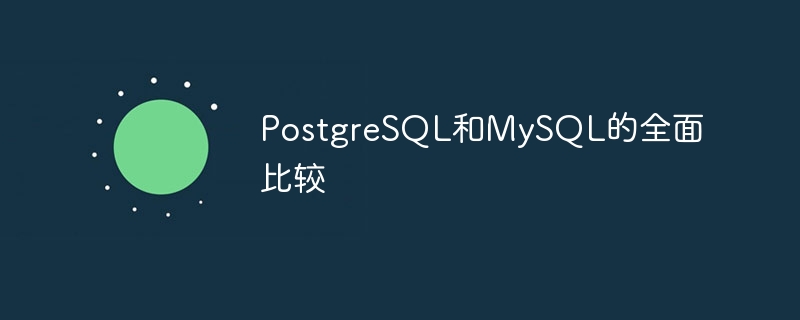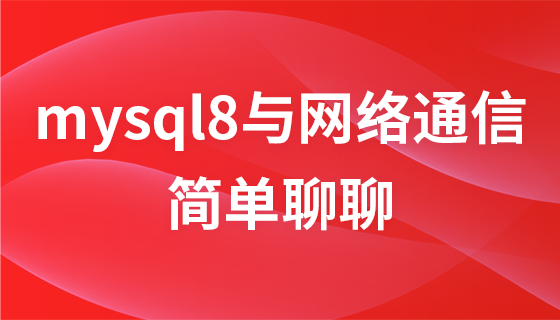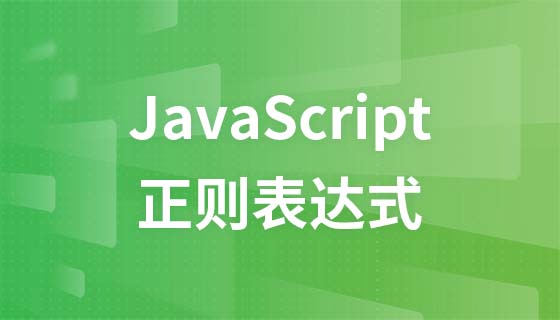PostgreSQL和MySQL的全面比较
来源:dev.to
时间:2024-09-23 19:06:53 151浏览 收藏
今日不肯埋头,明日何以抬头!每日一句努力自己的话哈哈~哈喽,今天我将给大家带来一篇《PostgreSQL和MySQL的全面比较》,主要内容是讲解等等,感兴趣的朋友可以收藏或者有更好的建议在评论提出,我都会认真看的!大家一起进步,一起学习!

介绍
让我们快速了解一下 PostgreSQL 和 MySQL。这两者都是重要的开源关系数据库管理系统,广泛应用于不同的应用程序。
技术架构和设计理念
起源与发展
PostgreSQL起源于1986年伯克利的POSTGRES项目,旨在通过严谨的学术研究和严格的SQL标准来推进数据库管理系统。这一背景为 PostgreSQL 提供了专注于数据一致性的坚实理论基础,使其成为复杂查询和高级数据类型的理想选择。其设计强调长期稳定性、可扩展性和社区驱动的创新。
相比之下,MySQL 由 Michael Widenius 和 David Axmark 创建于 1995 年,优先考虑实用性和易用性,以满足快速发展的互联网应用的需求。它简化了数据库管理并提高了性能,在互联网繁荣时期迅速成为 Web 开发人员的首选。 MySQL 的重点始终是性能和易于部署。
数据库引擎
MySQL 的显着特点是支持多种数据库引擎,允许用户根据自己的需求选择最佳的存储方式。从5.5版本开始,InnoDB一直是默认引擎,支持事务和行级锁定,以实现高并发和数据一致性。 MyISAM虽然提供了更好的读性能,但缺乏事务支持,适合读密集型场景。 MySQL 还为特定用例提供了 Memory 和 Archive 等引擎。
相比之下,PostgreSQL 使用统一的核心引擎,确保所有功能的一致性和互操作性。此设计支持复杂查询、事务管理和高级数据类型,同时简化维护。尽管在某些情况下不如 MySQL 灵活,但 PostgreSQL 的内部灵活性和可扩展性通过分区和查询优化等功能得到了增强。
比较 SQL 语法和功能
比较分析揭示了数组类型支持、JSON 处理、事务管理、临时表、窗口函数、递归查询、数据类型丰富性、默认值约束和区分大小写等方面的差异和相似之处:
| SQL Syntax/Feature | PostgreSQL | MySQL | Description |
|---|---|---|---|
| Array Types | Supported | Not directly supported | PostgreSQL allows direct definition of array type fields. MySQL simulates arrays using strings or other indirect methods. |
| JSON Support | Powerful | More basic | PostgreSQL has advanced JSON support with indexing and optimized queries. MySQL’s JSON support has improved in recent versions but remains simpler. |
| Transaction Handling | Fully ACID | Default auto-commit | PostgreSQL pulls off full ACID compliance by default, ideal for high-consistency scenarios. MySQL defaults to auto-commit for each statement but can be configured for transaction handling. |
| Temporary Tables | Session/Global Scope | Session Only | PostgreSQL allows both session-level and global temporary tables, while MySQL supports only session-level ones. |
| Window Functions | Supported | Supported since later versions | PostgreSQL has long supported window functions; MySQL added full support in more recent versions. |
| CTE (Common Table Expressions) | Supported | Supported | Both support CTE, but advanced usages or performance may vary. |
| Recursive Queries | Supported | Supported since version 8.0 | PostgreSQL has supported recursive queries for a while, while MySQL started in version 8.0. |
| Data Types | More varied (like ARRAY, HSTORE, GIS types) | Basic types are comprehensive | PostgreSQL supports more specialized data types, while MySQL has a good set of basic types but not as diverse as PostgreSQL. |
| Default Value Constraints | Supports any expression | Has many limitations | PostgreSQL allows defaults to be any expression, whereas MySQL’s defaults are usually constants. |
| Case Sensitivity | Configurable | Defaults to case-insensitive | PostgreSQL can configure case sensitivity at the database or column level, while MySQL defaults to case-insensitive unless using binary collation. |
注意:随着时间的推移,两个系统都会不断更新,特定功能的支持和性能可能会发生变化。选择数据库时最好查阅最新的官方文档或发行说明。
高级功能比较:数据类型和事务处理
| Feature/Database | PostgreSQL | MySQL |
|---|---|---|
| Advanced Data Types | Supports arrays, JSONB, hstore, etc., for complex data structures. | Supports JSON (enhanced in newer versions), but doesn't natively support arrays or hstore, needing indirect methods. |
| Window Functions | Early support for window functions, suitable for a variety of complex data analytics scenarios. | Added window functions in newer versions, progressively improving functionality but might lag in maturity and community resources. |
| Transaction Isolation Levels | Supports READ UNCOMMITTED, READ COMMITTED, REPEATABLE READ, SERIALIZABLE, fully compliant with SQL standards. | Also supports these four isolation levels, but defaults to REPEATABLE READ and implements them via different storage engines (like InnoDB). |
| MVCC Implementation | Strong MVCC mechanism maintains multiple versions for each row, allowing for lock-free reads to enhance concurrency. | InnoDB uses MVCC via Undo Logs to maintain transaction views, optimizing read and write concurrency with its own locking strategies. |
| Locking Mechanism | Supports row-level locking combined with multi-version concurrency control, reducing lock contention and improving concurrency efficiency. | InnoDB supports row-level locking; MyISAM and other engines use table locks. Row-level locking improves concurrency but can be influenced by locking strategies and transaction designs. |
数据类型和功能特征
- 高级数据类型:PostgreSQL 提供了更丰富的选项,如数组、JSONB、hstore,使其适合复杂的数据处理。
- 窗口函数和分析查询:PostgreSQL 早期已经支持这些,而 MySQL 在较新的版本中添加了它们。
- 事务处理和并发控制:比较它们的隔离级别、MVCC 实现和锁定机制,显示出关键差异。
性能和可扩展性比较
| Feature/Database | PostgreSQL | MySQL |
|---|---|---|
| Benchmarking and Workload | - Excels in complex queries and joins, thanks to rich indexing types and an optimizer. - Good balance for write-heavy and mixed workloads. |
- Performs excellently in read-heavy scenarios, especially simple SELECT queries. - InnoDB engine optimizes read speed and handles concurrency well. |
| Scalability Strategy | - Supports partitioning for large tables to optimize query performance. - Parallel querying enhances large data processing capabilities. - Connection pooling management boosts concurrent processing. |
- Achieves scalability via third-party tools (like PgPool-II, Patroni) for high availability and extensibility. - Sharding is common for horizontally scaling, ideal for large data distribution. - Offers replication (master-slave), group replication for redundancy and separating reads and writes. |
| Horizontal Scalability | - Native support is limited but can implement complex distributed deployments with third-party tools. - Citus extension enables real distributed SQL processing. |
- Has more mature sharding solutions and clustering technologies, making horizontal scalability more flexible, especially for large internet applications. |
性能和可扩展性的深入比较
| Feature/Database | PostgreSQL | MySQL |
|---|---|---|
| Benchmarking and Workload | - With a powerful query optimizer and various indexing types, excels in complex query handling and analysis. - Balanced reading and writing, suitable for applications needing high-performance writing and complex analysis. - Excels in read-heavy contexts, particularly in simple SELECT queries, suited for web browsing and content distribution scenarios. - Optimizes read performance through read-write separation and caching strategies. |
- Specializes in read-heavy operations for simple SELECT queries, perfect for content management systems and e-commerce platforms, ensuring optimized reading performance. - MySQL supports InnoDB optimizations for read speed and concurrency handling. |
| Scalability Solutions | - Partitions support range, list, hash, and more, boosting large table query efficiency. - Automatically leverages multi-core CPUs for parallel querying, enhancing data retrieval speed. - 内置和第三方连接池管理优化资源使用和响应时间。 - Using extensions like Citus for distributed processing. - Sharding, either manual or automated, disperses storage and processes large datasets to improve read and write performance. - Replication mechanisms (master-slave, group) enhance data availability and reading scalability. |
- InnoDB Cluster provides integrated high availability and scalability solutions that simplify cluster management. |
性能和可扩展性
- 基准测试和工作负载:分析两个系统在不同工作负载下的性能,提到 MySQL 在读取密集型环境中的优势以及 PostgreSQL 在复杂查询中的效率。
- 可扩展性:讨论它们的水平可扩展性能力:MySQL 的分片策略与 PostgreSQL 的连接池、分区和并行查询功能。
安全性和合规性比较
| Feature/Database | PostgreSQL | MySQL |
|---|---|---|
| User Permission Management | - Fine-grained permission control with role and privilege inheritance, making it easier to manage complex permission structures. - Supports row-level security (RLS) for custom access control rules. - Provides a detailed user and permissions management system, with controls down to the database and table level. |
- Doesn't natively support row-level security but can implement it through application logic. |
| Encryption Features | - Supports SSL/TLS encrypted connections to secure data transmission. - Has field-level encryption plugins to enhance security when data is at rest. - Transparent Data Encryption (TDE) options can be implemented through third-party extensions. |
- Built-in SSL/TLS support protects network communications. - InnoDB storage engine supports table space encryption to secure data files. - MySQL Enterprise Edition offers more advanced encryption options. |
| Compliance Certification | - Complies with multiple security standards, including FIPS 140-2 and Common Criteria. - Supports data protection regulations like GDPR, but specific compliance measures need to be tailored to the environment. |
- Holds several international security certifications like PCI DSS and ISO 27001. - Supports SSL/TLS and TDE, aiding in compliance with regulations like HIPAA and GDPR. - MySQL Enterprise Edition provides enhanced auditing and security functions to strengthen compliance. |
安全与合规性
- 用户权限管理:PostgreSQL 擅长细粒度控制和行级安全性。 MySQL专注于应用层安全适配。
- 加密功能:两者都支持 SSL/TLS,但 PostgreSQL 通过扩展和对字段级加密的高级控制来包含 TDE 选项。
- 合规认证:两个数据库都遵守各种安全标准,但PostgreSQL拥有更广泛的认可认证,而MySQL的企业版则增强了合规能力。
应用场景及选型建议
| Database | Suitable Scenarios |
|---|---|
| PostgreSQL | - Data analytics and business intelligence: Strong capabilities for complex queries, window functions, and geospatial data processing. - High compliance industries like finance and healthcare: Robust security and compliance features. - Complex application development: Supports advanced data types and multi-version concurrency, ideal for transaction-heavy applications. |
| MySQL | - Web applications and startups: Lightweight, easy to deploy, rich community resources, quick development cycles. - Read-heavy services: Such as content management systems and e-commerce platforms with optimized read performance. - Cloud-native environments: Deep integration with various cloud providers, suited for quickly scalable internet services. |
决策框架
| Decision Factor | Considerations | PostgreSQL Tendency | MySQL Tendency |
|---|---|---|---|
| Data Scale and Complexity | Volume of data, query complexity | Large datasets, complex queries, multi-dimensional analysis | Small to medium datasets, simple queries |
| Transaction Processing Needs | Complexity and consistency of transactions | High-concurrency transactions, strict ACID requirements | Simple transaction handling, read/write separation scenarios |
| Budget and Costs | Software licensing, operational costs | Open-source and free, but may require more professional support | Open-source and low cloud service costs |
| Team Familiarity and Skills | Technical stack match, learning curve | Requires strong SQL skills, suited for experienced teams | Friendlier for beginners, lower learning curve |
注意事项
选择数据库时,没有一刀切的选择。相反,专注于最适合您需求的内容。在权衡这些因素时,请考虑运行小规模概念验证 (POC),以测试特定工作负载下的数据库性能,然后再做出最终决定。此外,这两个数据库系统都在不断改进并引入新功能,因此了解最新发展对于做出明智的选择至关重要。
文中关于的知识介绍,希望对你的学习有所帮助!若是受益匪浅,那就动动鼠标收藏这篇《PostgreSQL和MySQL的全面比较》文章吧,也可关注golang学习网公众号了解相关技术文章。
-
501 收藏
-
501 收藏
-
501 收藏
-
501 收藏
-
501 收藏
-
314 收藏
-
212 收藏
-
351 收藏
-
407 收藏
-
166 收藏
-
250 收藏
-
501 收藏
-
222 收藏
-
429 收藏
-
205 收藏
-
256 收藏
-
108 收藏
-

- 前端进阶之JavaScript设计模式
- 设计模式是开发人员在软件开发过程中面临一般问题时的解决方案,代表了最佳的实践。本课程的主打内容包括JS常见设计模式以及具体应用场景,打造一站式知识长龙服务,适合有JS基础的同学学习。
- 立即学习 543次学习
-

- GO语言核心编程课程
- 本课程采用真实案例,全面具体可落地,从理论到实践,一步一步将GO核心编程技术、编程思想、底层实现融会贯通,使学习者贴近时代脉搏,做IT互联网时代的弄潮儿。
- 立即学习 514次学习
-

- 简单聊聊mysql8与网络通信
- 如有问题加微信:Le-studyg;在课程中,我们将首先介绍MySQL8的新特性,包括性能优化、安全增强、新数据类型等,帮助学生快速熟悉MySQL8的最新功能。接着,我们将深入解析MySQL的网络通信机制,包括协议、连接管理、数据传输等,让
- 立即学习 499次学习
-

- JavaScript正则表达式基础与实战
- 在任何一门编程语言中,正则表达式,都是一项重要的知识,它提供了高效的字符串匹配与捕获机制,可以极大的简化程序设计。
- 立即学习 487次学习
-

- 从零制作响应式网站—Grid布局
- 本系列教程将展示从零制作一个假想的网络科技公司官网,分为导航,轮播,关于我们,成功案例,服务流程,团队介绍,数据部分,公司动态,底部信息等内容区块。网站整体采用CSSGrid布局,支持响应式,有流畅过渡和展现动画。
- 立即学习 484次学习
